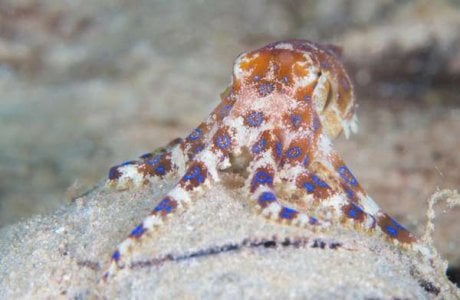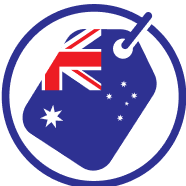Keep your distance: Council warns travellers over recent river sightings
By
Danielle F.
- Replies 4
Australia is renowned for its diverse and unique wildlife.
These creatures often capture the imagination and the caution of locals and visitors alike.
In a surprising turn of events, a creature not seen in Sydney since the 1960s has made a rare appearance, prompting a timely warning to the public.
The Inner West Council of Sydney recently alerted residents to an unusual sighting in the Parramatta River.
A blue-ringed Octopus has been discovered in Callan Park.
A council environmental officer spotted the animal during a routine water quality monitoring.
These inspections also assess local wildlife to gauge the overall condition of the river ecosystem.
Parramatta River has suffered from pollution over the years.
However, the presence of the blue-ringed octopus was seen as a positive sign of recovery.
In addition to the octopus, other marine life, such as seahorses and a local seal, have been spotted.
The blue-ringed octopus carries a deadly neurotoxin that could cause severe harm or death.
Despite the potential danger, the council expressed their excitement over the find.
'It's not what you would expect,' a spokesperson for the Inner West Council said in an interview.
'We are excited by it because it says the health of the river is pretty good.'
However, the council quickly reminded the public of their safety.
'Stay safe, keep your distance and don't touch!'
Australian Museum Research Institute's resident malacology expert, Alison Miller, previously noted that while these octopuses can camouflage themselves, they generally coexist peacefully if undisturbed.
However, there are still dangers when around a blue-ringed octopus.
A 43-year-old man experienced paralysis after having a close encounter with one at Balmoral Beach.
The sting led to the man's hospitalisation and temporary paralysis.
The toxin of the blue-ringed octopus, known as tetrodotoxin, is believed to be '1,000 times more powerful than cyanide'.
Surf Life Saving NSW advised that anyone bitten by the octopus should immediately call emergency services and apply a pressure bandage to the bitten area.
If breathing difficulties or paralysis occur, CPR may be necessary until medical help arrives.
It's essential to be aware of the potential dangers when enjoying Australia's beautiful waterways.
Remember to admire from a distance and never touch or disturb wildlife, no matter how intriguing it may seem.

Have you ever had a close encounter with Australia's unique wildlife? Share your experiences with us in the comments below, and let's continue to celebrate and protect the incredible creatures across the country.
These creatures often capture the imagination and the caution of locals and visitors alike.
In a surprising turn of events, a creature not seen in Sydney since the 1960s has made a rare appearance, prompting a timely warning to the public.
The Inner West Council of Sydney recently alerted residents to an unusual sighting in the Parramatta River.
A blue-ringed Octopus has been discovered in Callan Park.
A council environmental officer spotted the animal during a routine water quality monitoring.
These inspections also assess local wildlife to gauge the overall condition of the river ecosystem.
Parramatta River has suffered from pollution over the years.
However, the presence of the blue-ringed octopus was seen as a positive sign of recovery.
In addition to the octopus, other marine life, such as seahorses and a local seal, have been spotted.
While this octopus sighting indicated the river's improving health, experts warned Aussies about the small yet lethal marine animal.The blue-ringed octopus carries a deadly neurotoxin that could cause severe harm or death.
Despite the potential danger, the council expressed their excitement over the find.
'It's not what you would expect,' a spokesperson for the Inner West Council said in an interview.
'We are excited by it because it says the health of the river is pretty good.'
However, the council quickly reminded the public of their safety.
'Stay safe, keep your distance and don't touch!'
Australian Museum Research Institute's resident malacology expert, Alison Miller, previously noted that while these octopuses can camouflage themselves, they generally coexist peacefully if undisturbed.
However, there are still dangers when around a blue-ringed octopus.
A 43-year-old man experienced paralysis after having a close encounter with one at Balmoral Beach.
The sting led to the man's hospitalisation and temporary paralysis.
The toxin of the blue-ringed octopus, known as tetrodotoxin, is believed to be '1,000 times more powerful than cyanide'.
Surf Life Saving NSW advised that anyone bitten by the octopus should immediately call emergency services and apply a pressure bandage to the bitten area.
If breathing difficulties or paralysis occur, CPR may be necessary until medical help arrives.
It's essential to be aware of the potential dangers when enjoying Australia's beautiful waterways.
Remember to admire from a distance and never touch or disturb wildlife, no matter how intriguing it may seem.
Key Takeaways
- The Inner West Council alerted residents to a potentially lethal and rare sighting of a blue-ringed octopus in the Parramatta River.
- It was the first sighting of this deadly animal in the river system since the 1960s, indicating improved river health.
- The council advised the public to admire the creature from a distance and refrain from touching it to avoid its neurotoxin.
- A previous incident highlighted the potential dangers of the blue-ringed octopus' toxins.








